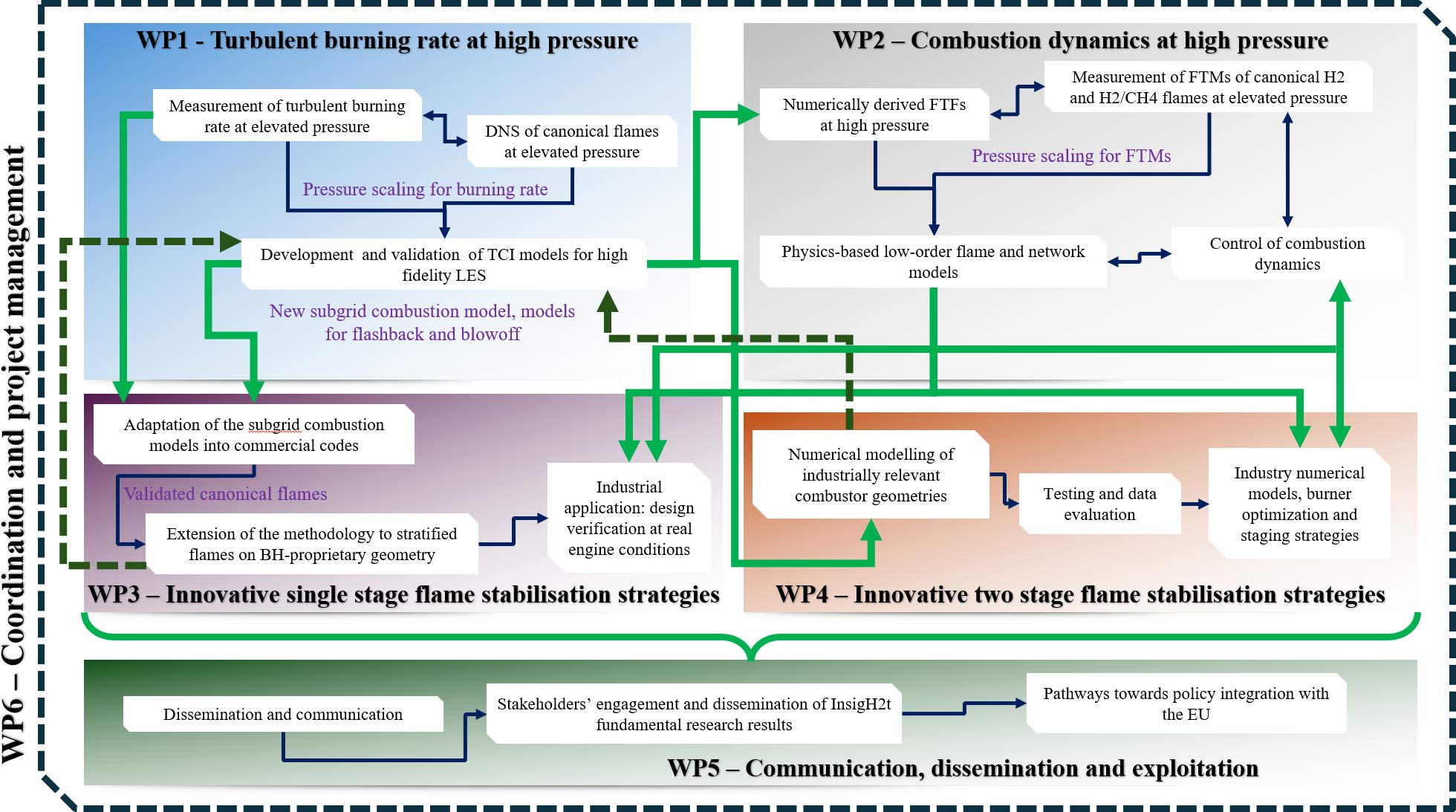InsigH2t is planned to last 48 months – from January 2025 to December 2028.
It is divided into 6 Work Packages (WP) that are mutually related.

WP1 – Understanding the turbulent burning rate of premixed H2 and CH4/H2 flames at high pressure
WP1 main objectives are:
- Establish an experimental database of the turbulent burning rate of H2-air and CH4/H2-air flames (H2>80% vol) at elevated pressure conditions
- Establish a database of DNS of the canonical flame configurations for H2-air flames at elevated pressure to investigate the effect of pressure on the turbulent burning rate and flame stabilisation
- Develop and validate a new turbulence-chemistry combustion model that can accurately capture the turbulent rate in high fidelity large-eddy simulations (LES) of the canonical flame configurations
WP2 – Understanding the combustion dynamics of premixed H2 and CH4/H2 flames at high pressure
WP2 main objectives are:
- Setup of experimental database of dynamic flames responses and emissions from atmospheric to elevated pressure conditions
- Physics-informed models for flames responses validated with experiments and high-fidelity LES of forced canonical premixed H2/air flames
- Setup and validation of low-order models for pressure dependent operating conditions
- Derivation and validation of passive strategies for mitigation of combustion dynamics
WP3 – Improved single stage flame stabilisation strategies for industrial GT
WP3 main objectives are:
- Validation of the canonical flames studied in WP1 using commercial CFD codes
- Investigation of industrial burners operating at tested conditions in terms of oxidizer temperature and ambient pressure
- Investigation of industrial burners operating at engine representative pressure conditions.
- Burner design improvements and simulations
WP4 – Development of innovative two stage flame stabilisation strategies for heavy-duty GTs
WP4 main objectives are:
- In-house numerical modelling of industrially relevant combustor geometries
- High pressure combustion tests definition and preparation
- Test campaign execution and provision of test data of industrially relevant sequential combustion geometries
- Validation of improved numerical models and optimisation of combustion system layout, fuel injection and fuel staging strategies for heavy duty GT application.
WP5 – Communication, Dissemination, Exploitation
WP5 main objectives are:
- Raise awareness of the project activities and objectives
- Disseminate project results to relevant stakeholders
- Promote the project and its benefits to a wider audience
- Consolidate synergies with other EU-funded projects and other initiatives
- Present pathways for integration of specific results into EU policies
WP6 – Coordination and project management
WP6 main objectives are:
- Ensure the proper overall management and scientific coordination of the project, by supporting the participants in achieving the project objectives and milestones according to the timelines and deliverables committed to in the work plan, and within the planned budget.
- Ensure that the consortium’s contractual duties are carried out in compliance with EU regulations.
- Set-up an effective internal communication infrastructure & foster the integrative process within the consortium.
- Identify possible risks, set-up mitigation measures and contingencies and to define measurable indicators for project progress.
- Set-up a data management plan and keep it up to date.